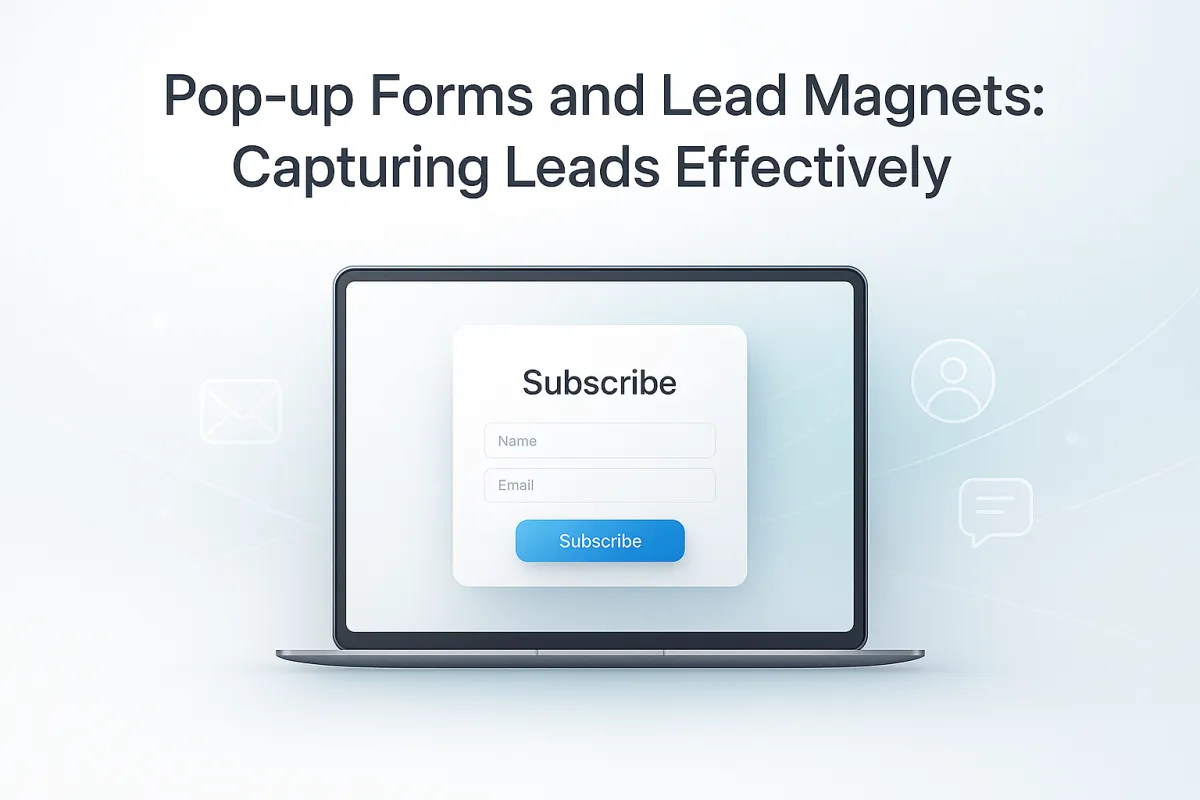
Pop-up Forms and Lead Magnets: Capturing Leads Effectively
Introduction to Lead Capture Strategies
Did you know more than 80% of website visitors leave without taking any action? That’s a staggering number of missed opportunities. In the fast-paced digital landscape of 2025, where consumer expectations are higher than ever, businesses can't afford to let potential leads slip through the cracks. Fortunately, two proven tactics, pop-up forms and lead magnets, remain among the most effective tools to capture leads and fuel business growth.
This comprehensive guide covers everything you need to know about using pop-up forms and lead magnets to engage visitors, capture qualified leads, and nurture prospects into customers. Whether you're an entrepreneur, marketer, or business strategist, you'll walk away with practical insights, step-by-step strategies, common pitfalls to avoid, and the latest tools powering modern lead capture.
Let’s explore how to build a high-performing lead generation machine that converts.
Understanding Lead Magnets
Definition and Purpose
A lead magnet is a valuable resource offered to users in exchange for their contact information, typically their name and email address. It incentivizes engagement and builds trust between your business and a prospective customer.
Lead magnets can be downloadable guides, templates, quizzes, webinars, tools, or exclusive access offers. The goal is to deliver immediate, tangible value that solves a specific problem for your audience.
Why Lead Magnets Matter in 2025
Consumers expect hyper-personalized experiences. Outdated PDFs and generic eBooks no longer work. In 2025, high-performing lead magnets are:
Interactive (quizzes, calculators, or assessments)
AI-personalized and data-driven
Instantly accessible
Problem-solving and specific to the buyer’s journey
Types of Effective Lead Magnets
Interactive Tools (ROI calculators, quizzes, assessments)
2x higher engagement than static content.
Templates and Checklists
Practical, ready-to-use resources that save time.
Free Resources
Short, scannable eBooks or mini-guides that deliver quick wins.
Exclusive Access Offers
Communities, early-bird launches, or limited access trials.
Multi-Step Funnels with AI Tools
Dynamic lead paths that deliver personalized results instantly.
Designing High-Converting Pop-up Forms
Best Practices
Use concise headlines that communicate clear value.
Limit form fields to name and email.
Deliver lead magnets instantly via automation (for example, Go HighLevel).
Keep the design on-brand and visually minimal.
Timing and Triggers
Avoid overwhelming visitors with frequent pop-ups. Instead, use smart triggers:
Exit-intent (as users move to close the tab)
Scroll depth (after 50–70% of page engagement)
Time delay (15–60 seconds after arrival)
Inactivity (if no action after 10+ seconds)
Mobile Optimization
Pop-ups should be vertically aligned and responsive.
Include short copy, large buttons, and clear exit options.
Always preview on multiple screen sizes.
Creating a Seamless Lead Capture Experience
Align with Audience Pain Points
The best lead magnets solve real problems. Use analytics, surveys, and persona mapping to pinpoint what your audience struggles with, then tailor your offers.
Personalize by Funnel Stage
TOFU: Awareness content like quizzes or guides
MOFU: Calculators, templates, or checklists
BOFU: Strategy sessions, demos, or consultations
Build Trust Through Value
Your lead magnet should overdeliver. Treat it like a mini product, not a teaser. When users experience value upfront, they’re more likely to convert later.
SEO Best Practices for Lead Capture Content
Keyword Optimization
Focus on long-tail intent-based phrases like:
“free marketing audit template”
“lead magnet ideas for small businesses”
Place them naturally in headers, image alt-text, and meta descriptions.
Readable Structure
Use short paragraphs and clear headings.
Employ bullet lists for quick scanning.
Include Q&A-style sections to target featured snippets.
Optimized Metadata
Meta titles and descriptions should include your target keyword and value-driven phrasing within character limits:
Title: Up to 59 characters
Description: 150–160 characters
Measuring and Optimizing Lead Capture Performance
Key Metrics to Track
Conversion rate (visits → sign-ups)
Bounce rate (content relevance)
Form completion rate
Lead-to-customer conversion ratio
A/B Testing Variables
Pop-up timing
CTA text and design
Form length and fields
Lead magnet formats
Use platforms like Go HighLevel and Google Analytics for data-backed insights.
Common Mistakes to Avoid
Using generic, overused lead magnets
Poor mobile optimization
Overcomplicating form fields
Ignoring post-sign-up engagement
Failing to test and refine design triggers
Frequently Asked Questions
Q: What makes a lead magnet successful?
A: Relevance, simplicity, and value. It should solve a real problem instantly.
Q: How many pop-ups are too many?
A: One per session is ideal. More than two can lead to higher bounce rates.
Q: Should I gate all my resources?
A: No. Offer a mix of free and gated content to build both reach and conversions.
Conclusion: Turning Visitors Into Lifelong Leads
Pop-up forms and lead magnets are not about collecting emails, they’re about creating meaningful connections. When executed correctly, they become the backbone of your growth strategy, turning casual visitors into loyal customers.
Remember: value, timing, and experience define success. If your lead magnet feels helpful and your pop-up feels natural, you’ll convert attention into action every time.
Want to see how optimized lead funnels can transform your business?
Read more at https://ozlon.net/the-marketing-blog
